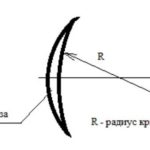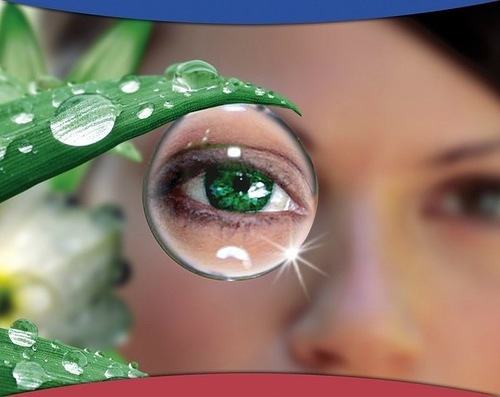Types and types of contact lenses
 There was a time when serious problems with the organs of vision were observed only in the older generation, but now the situation has changed dramatically.
There was a time when serious problems with the organs of vision were observed only in the older generation, but now the situation has changed dramatically.
The era of information technology has given us a lot of gadgets and advantages in obtaining the necessary information in comparison with our grandparents, but sometimes the benefits of civilization that were previously unavailable can be harmful.
Fast Internet (videos), widescreen TV, computer games and remote work - we pay for all this with our eyesight, which can rapidly deteriorate if we do not see a doctor in time, we can partially lose it and then require the intervention of a surgeon.
It is possible to wear glasses, then first consult an ophthalmologist and wear them for your health. But the article will focus on contact lenses; for many people they have become an integral part of life, do not cause discomfort if used correctly and are completely invisible, and therefore do not affect the appearance of the person wearing them. There are cosmetic types - they change the color of the iris depending on preferences.
The content of the article
Hard
 Prescribed by the attending physician for complicated astigmatism, keratoconus (degenerative inflammation of the eye, occurs when the cornea thins, which takes on a conical shape, sometimes leading to serious vision complications).
Prescribed by the attending physician for complicated astigmatism, keratoconus (degenerative inflammation of the eye, occurs when the cornea thins, which takes on a conical shape, sometimes leading to serious vision complications).
If you blink, this type puts some pressure on the surface of the cornea, while maintaining its original shape and thereby increasing visual acuity. When using them, allergic reactions rarely occur, they are more durable, hold their shape better than soft ones, and are easier to clean.
They are:
- As gas-permeable, they consist of silicone compounds with fluorine. There are disadvantages - this is the active absorption of fats contained in creams and cosmetics;
- So gas-tight, used previously, are now less common.
Soft
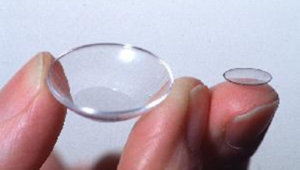 Prescribed by the attending physician to normalize vision when a patient is diagnosed with myopia, astigmatism or farsightedness. They are held in place by capillary action.
Prescribed by the attending physician to normalize vision when a patient is diagnosed with myopia, astigmatism or farsightedness. They are held in place by capillary action.
Lenses are selected at will and can change the color of the iris. They are more comfortable to wear, allow air and moisture to pass through, and there is no discomfort on the retina. They come with different hydrophilicity:
- 50% or more – high;
- 50% or less – low degree of hydrophilicity.
Replacing lenses with new ones - soft and hard
- For everyday replacement - suitable for people who value their time and care about their health;
- For planned and frequent replacement, it is recommended to replace them with new ones after a week or two, depending on the recommendations of an ophthalmologist;
- For a planned replacement, it should occur after one or six months. They are divided into monthly, quarterly and semi-annual.
Planned ones are resistant to protein and protein deposits, which makes it difficult for microorganisms to spread, and are recommended to be worn for up to fifteen hours a day.
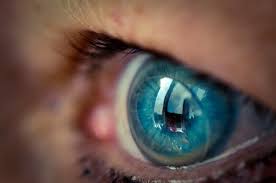 Traditional soft lenses should be used for no more than a year, while hard lenses, which are more durable, are used for several years.Hard ones stand out from others due to their low breathability and low moisture content; sometimes the above parameters can lead to discomfort when worn for a long time.
Traditional soft lenses should be used for no more than a year, while hard lenses, which are more durable, are used for several years.Hard ones stand out from others due to their low breathability and low moisture content; sometimes the above parameters can lead to discomfort when worn for a long time.
Use up to 10 hours a day. When using, in order not to infect the eyes, you need to use a cleaning solution that a doctor can recommend, enzyme tablets, but best of all, just buy saline solution at the pharmacy and use it for cleaning. Before doing this, do not forget to wash your hands with soap that does not contain dyes or essential oils.
Everyone should know this: Regardless of how long you wore these lenses, be it a day, a month or a year, at the end of the scheduled replacement period, it can last from one day to a whole year, they must be purchased again, and the old ones must be disposed of.
Wearing mode
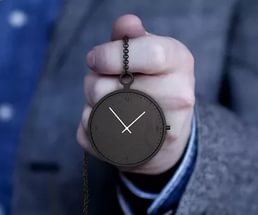
- (FW) Flexible mode, do not remove for one or two days, as is more convenient for the lens user;
- (DW) Day mode, will have to be removed at night;
- (EW) If prolonged, you will have to live with them for seven days;
- (CW) Continuously, for a whole month, the lenses will protect the vision of their owner. These are gas-tight rigid and silicone-hydrogel.
Types of design
- Spherical in shape, used to correct vision problems such as myopia and farsightedness;
- Aspherical shape, for vision problems listed in the paragraph above;
- Toric shape, necessary for astigmatism;
- Multifocal form, used to correct senile farsightedness.
Purpose
- Optical – used to correct vision defects (presbyopia, myopia, astigmatism and farsightedness);
- Intended for sports, it makes colors more contrasting, yellow is used for games such as tennis;
- Cosmetic lenses - help hide newly acquired or congenital visual defects of the visual organ (clouding of the cornea or a bulge of the iris);
- Decorative lenses - they change the natural color of the iris, they are tinted and known as Carnival or “Crazy” - the latter are coated with a pattern or various color effects. The peak of popularity comes during the holidays - New Year, Halloween and various themed events. But this is more of a fashion accessory, and not a means of correcting the visual organ;
- Therapeutic lenses are used as a bandage due to their high hydrophilicity and for better absorption of various medications into the tissues of the visual organ.
Degree of transparency
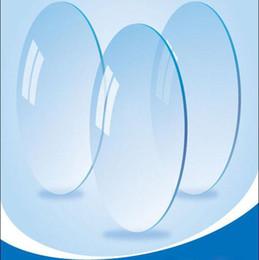
Lenses depend on their purpose and are either tinted or clear, which do not stain the iris. Tinted lenses are produced to make them easier to detect in a disinfectant solution where they can be stored.
Tinted, unlike cosmetic ones, do not change the natural color of the eyes and do not give it different shades.
Special treatment lenses
The use of scleral lenses is in situations where conventional ones cannot be used or it can be dangerous for the patient, for example: corneal modifications, post-operative restoration of corneal scars, severe cases of “dry eye” and complications of keratoconus. These lenses are larger than regular lenses, they completely cover the cornea and rest on the sclera. They are individually manufactured and selected for each patient.
There are different diameters:
- Scleral – this is 18.1 – 24.0 mm;
- Corneoscleral – this is 12.9 – 13.5 mm;
- Mini scleral ones are 15.0 – 18.0 mm;
- Semi-scleral is 13.6 – 14.9 mm.
Orthokeratological

They can temporarily correct various visual defects, but the high price, as well as difficulties in individual selection, are rarely used.
When worn at night, the thickness of the cornea increases and their shape changes, which affects the optical power of vision. The effect usually lasts for several days. They are recommended to be worn by athletes and people who, due to their specialty (working in dusty and poorly ventilated areas), cannot afford to change lenses on their own in a timely manner.
Hybrid contact lenses
It is best used if the patient’s visual organs are individual intolerant of hard type lenses; this solution provides increased visual acuity as with hard ones, with the comfort and advantages of soft type lenses.
The center of the lens is made in a spherical shape and is located above the cornea, it is rigid, and the lens itself rests on the edges, which are soft and do not cause discomfort to the patient.



